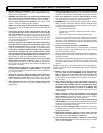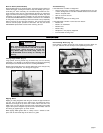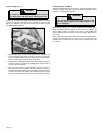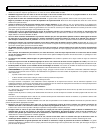
page 10
1. Beginning at a corner, line up the line sight with your cutting line. Tilt
the saw forward, firmly fixing the front of the shoe on the work-
piece. The blade should be just above cutting line, but not touching it.
Raise the lower guard using the lower guard lever.
2. Pull the trigger, allowing the blade to come up to full speed. Using the
front of the shoe as a hinge point, gradually lower the back end of
the saw into the workpiece.
3. When the shoe rests flat against workpiece, advance the saw to
the far corner. Release the trigger and allow the blade to come to a
complete stop before removing it from workpiece. Repeat the above
steps for each side of the opening. Use a Sawzall
®
, jig saw or small
hand saw to finish the corners if they are not completely cut through.
To reduce the risk of electric shock, check work area
for hidden pipes and wires before making pocket cuts.
WARNING!
Pocket Cutting (Fig. 11)
Pocket cuts are made in the middle of the workpiece when it can not be
cut from an edge. We recommend using a Sawzall
®
or jig saw for this
type of cut. However, if you must use a circular saw to make a pocket
cut, USE EXTREME CAUTION.
Only use abrasive cutting wheels with a maximum safe
operating speed greater than the RPM marked on the
tool's nameplate.
WARNING!
Fig. 11
When cutting masonry, use a silicone carbide abrasive cutting wheel.
Make successive passes at depths of less than 1/4" to achieve the
desired depth. Cutting at a depth of more than 1/4" will damage the
wheel. Frequently clean dust from air vents and guards. Always wear a
dust mask.
When cutting light gauge sheet metal, use an aluminum oxide abrasive
cutting wheel. Set the depth of cut for 1/8" to 1/4" greater than the
thickness of the material you are cutting. Protect everyone in the area
from sparks.
Cutting Masonry and Metal
Although MILWAUKEE Circular Saws are primarily designed and in-
tended for cutting wood, they may also be used with abrasive cutting
wheels for cutting metal or masonry.


















